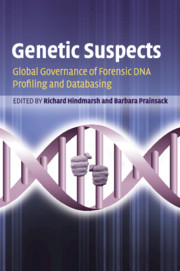Book contents
- Frontmatter
- Contents
- List of contributors
- About the contributors
- Foreword
- Acknowledgements
- 1 Introducing Genetic Suspects
- Section 1 Key areas in DNA profiling and databasing
- Section 2 National contexts of forensic DNA technologies and key issues
- 7 DNA databases and the forensic imaginary
- 8 Partners in crime: the use of forensic DNA technologies in Austria
- 9 Inquisitorial forensic DNA profiling in the Netherlands and the expansion of the forensic genetic body
- 10 DNA the Nor-way: black-boxing the evidence and monopolising the key
- 11 Portuguese forensic DNA database: political enthusiasm, public trust and probable issues in future practice
- 12 On trial! Governing forensic DNA technologies in the USA
- 13 Biosurveillance and biocivic concerns, from ‘truth’ to ‘trust’: the Australian forensic DNA terrain
- 14 Finding the balance: forensic DNA profiling in New Zealand
- 15 Forensic DNA profiling and databasing: the Philippine experience
- Section 3 Conclusions
- Index
- References
8 - Partners in crime: the use of forensic DNA technologies in Austria
from Section 2 - National contexts of forensic DNA technologies and key issues
Published online by Cambridge University Press: 05 October 2012
- Frontmatter
- Contents
- List of contributors
- About the contributors
- Foreword
- Acknowledgements
- 1 Introducing Genetic Suspects
- Section 1 Key areas in DNA profiling and databasing
- Section 2 National contexts of forensic DNA technologies and key issues
- 7 DNA databases and the forensic imaginary
- 8 Partners in crime: the use of forensic DNA technologies in Austria
- 9 Inquisitorial forensic DNA profiling in the Netherlands and the expansion of the forensic genetic body
- 10 DNA the Nor-way: black-boxing the evidence and monopolising the key
- 11 Portuguese forensic DNA database: political enthusiasm, public trust and probable issues in future practice
- 12 On trial! Governing forensic DNA technologies in the USA
- 13 Biosurveillance and biocivic concerns, from ‘truth’ to ‘trust’: the Australian forensic DNA terrain
- 14 Finding the balance: forensic DNA profiling in New Zealand
- 15 Forensic DNA profiling and databasing: the Philippine experience
- Section 3 Conclusions
- Index
- References
Summary
INTRODUCTION: AUSTRIA'S ‘FIRST SERIAL KILLER’ AND THE ESTABLISHMENT OF THE FORENSIC DNA DATABASE
In spring 2008, the small Alpine republic of Austria made it into world headlines in the reporting on a bizarre and disconcerting criminal activity. On 27 April, police had discovered a cellar dungeon in which 42-year-old Elisabeth F. had been abused and held captive by her father for 24 years. During that period she bore seven children, of whom six survived. Upon being rescued by the police, some of Elisabeth's children saw sunlight for the first time in their lives. The entire world was in shock.
Many Austrians remembered that this was not the first time they had made headlines with a horror story. Johann (‘Jack’) Unterweger, the illegitimate son of a Viennese prostitute and a member of the US Armed Forces, ‘gave Austria its first serial killer’, as an Austrian weblog put it. At age 24, Unterweger was sentenced to life in prison after murdering an 18-year-old German woman who, as he later stated, reminded him of his mother (Gepp 2007). He spent his life in prison writing short stories and he also authored a book, an autobiography titled Purgatory: A Journey to Jail (1983), which in a twist had also rendered him the darling of the local celebrity scene. Released from prison in 1990 – after having served only 16 years of his life sentence as a result of devoted lobbying efforts on the part of celebrity friends – Unterweger was celebrated as a model case of rehabilitation.
- Type
- Chapter
- Information
- Genetic SuspectsGlobal Governance of Forensic DNA Profiling and Databasing, pp. 153 - 174Publisher: Cambridge University PressPrint publication year: 2010
References
- 5
- Cited by

